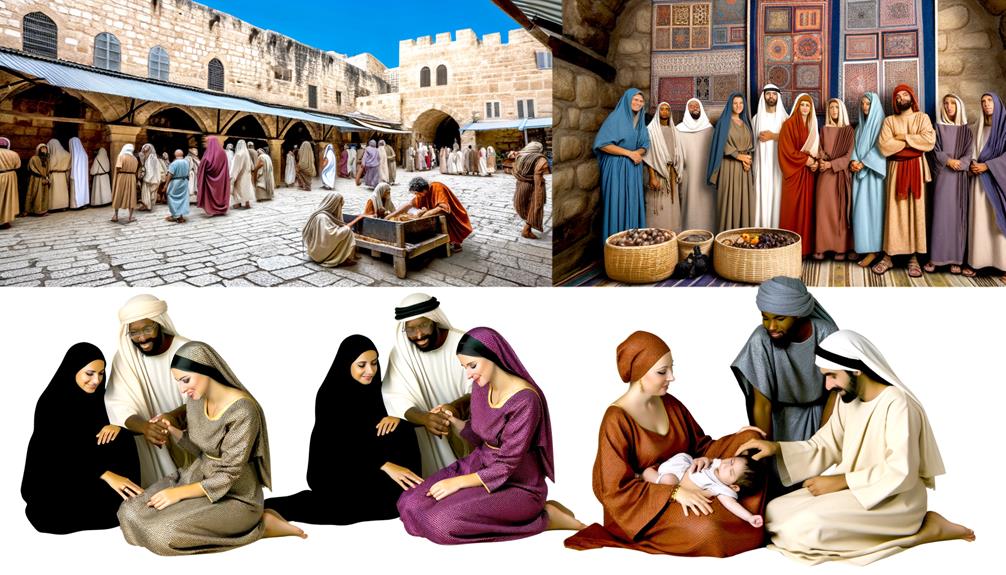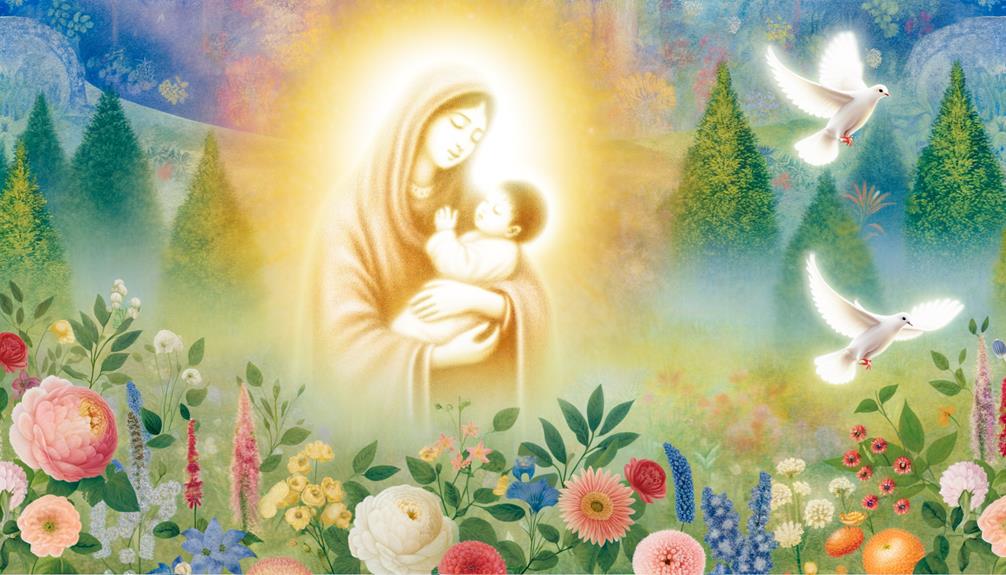Behold Your Mother Bible Verse Meaning: Compassion
In John 19:26-27, the phrase “Behold your mother,” spoken by Jesus at His crucifixion, signifies a profound redefinition of familial bonds, transcending biological ties to establish a new spiritual kinship among believers. This directive to the beloved disciple to care for Mary emphasizes the importance of community and relational responsibility in the early Christian context.
It reflects Jesus’ concern for human relationships and encapsulates a theology of inclusivity and unity within the faith community. This moment not only underscores Jesus’ divine mission but also enhances our understanding of early Christian identity and communal bonds.
Continue to explore the multifaceted implications of this transformative declaration.

The Meaning of ‘Behold Your Mother’ in the Bible: A Symbol of Care, Community, and Spiritual Responsibility
| Aspect | Biblical Meaning | Scriptural Significance |
|---|---|---|
| Care and Compassion | In this passage, Jesus speaks from the cross, instructing the disciple John to take care of Mary, His mother, saying, “Behold your mother.” It symbolizes the importance of care and compassion for one another. | Found in John 19:26-27, where Jesus entrusts His mother’s care to the beloved disciple, representing a deep act of compassion in His final moments. |
| Spiritual Family | Jesus’ words reflect the idea that the community of believers is to function as a spiritual family, where relationships of care and responsibility extend beyond blood ties. | Symbolizes the creation of a new spiritual family through faith, where Christians are called to look after each other as family members. |
| Responsibility for Others | “Behold your mother” emphasizes the responsibility we have to care for those who are vulnerable, such as the elderly or those in need, as part of our Christian duty. | Encourages believers to take on the responsibility of caring for others, especially those who may be in need of support and protection. |
| Jesus’ Love for His Mother | In this moment, Jesus expresses His deep love for Mary, ensuring her care after His death. It is a demonstration of His concern for her well-being even in His suffering. | Reflects the humanity of Jesus and His love for His mother, underscoring the importance of honoring and caring for parents. |
| Establishment of Community | This verse highlights the idea of creating a supportive, interconnected community, where individuals care for one another’s needs, especially in times of loss or hardship. | Represents the model of Christian community and the need for believers to form strong, supportive relationships. |
| Symbol of Motherhood and Honor | The phrase “Behold your mother” also represents the respect and honor that should be given to motherhood, emphasizing the value of maternal care in both spiritual and familial contexts. | Reflects the biblical call to honor mothers and maternal figures, in line with the fifth commandment: “Honor your father and your mother” (Exodus 20:12). |
| Spiritual Adoption | Jesus’ act of entrusting His mother to John symbolizes spiritual adoption, where believers are bound not only by faith but by acts of love and commitment to each other. | Demonstrates the bond of spiritual family, where love and care transcend biological ties, creating deeper connections within the faith community. |
| Encouragement to Serve Others | The command to “Behold your mother” can be seen as a call for believers to serve others, particularly those who are grieving, vulnerable, or in need of care. | Reflects Jesus’ example of selfless service and care, encouraging us to actively support and uplift one another. |
Historical Context

Understanding the historical context of a Bible verse is essential for comprehending its original meaning and significance within the broader narrative of the scripture.
The phrase ‘Behold your mother‘ found in John 19:26-27 occurs during a pivotal moment in the New Covenant—Jesus’ crucifixion. This directive, spoken by Jesus to his beloved disciple, John, and his mother, Mary, underscores the establishment of a new familial bond among believers.
In the first-century Judeo-Christian context, familial ties were paramount, and Jesus’ words redefined relational structures, emphasizing spiritual kinship over biological connection.
This historical backdrop enriches our understanding of the verse, revealing its profound implications for community, care, and the early Christian identity formation.
Biblical Source

The Gospel of John provides a unique perspective within the New Scriptures, distinct in its theological depth and emphasis on the divinity of Christ.
Exploring the context and significance of this Gospel is essential for understanding its contribution to Christian doctrine and its impact on the interpretation of biblical verses.
Gospel of John
A critical examination of the Gospel of John reveals its unique theological perspective on the divinity and humanity of Jesus Christ.
Unlike the Synoptic Gospels, John emphasizes the preexistence and incarnational aspects of Jesus, portraying Him as the Logos made flesh (John 1:14).
This Gospel distinctively integrates high Christology with intimate, relational narratives, aiming to underscore Jesus’ divine authority and his close relationships with individuals.
The text serves as a profound theological document that highlights Jesus’ miraculous signs, deep discourses, and personal interactions.
These elements collectively underscore John’s intent to present Jesus as both the divine Son of God and a compassionate human being, thereby offering a holistic view that is both lofty and accessible.
Context and Significance
In examining the context and significance of biblical sources, it is essential to contemplate the historical, cultural, and theological frameworks within which these texts were written and received.
The verse ‘Behold your mother‘ found in John 19:26-27 carries profound implications.
Historically, it reflects the Jewish customs of familial responsibility, where Jesus entrusts Mary to the beloved disciple, ensuring her care.
Culturally, this act underscores the importance of community and relational bonds in the early Christian context.
Theologically, it illustrates Jesus’ concern for human relationships and the establishment of a new spiritual family among believers.
This verse, consequently, encapsulates a multidimensional significance, bridging personal care with broader ecclesiastical themes.
Jesus’ Crucifixion

Examining the accounts of Jesus’ crucifixion across the Gospels reveals not only the historical and theological significance of this event but also its profound impact on Christian doctrine and practice.
The crucifixion narrative is central to understanding the redemptive nature of Jesus’ sacrifice and its implications for humanity.
Key elements include:
- The fulfillment of Old scriptures prophecies
- The significance of Jesus’ suffering and death
- The role of the crucifixion in atonement theology
- The portrayal of Jesus as the suffering servant
These aspects collectively underscore the salvific purpose of Jesus’ death, shaping Christian worship, liturgy, and the theological foundation of salvation through Christ.
Addressing Mary

The manner in which Mary is addressed in the Bible carries profound implications that extend beyond mere familial ties.
By examining the biblical context, symbolic interpretations, and the significance of her relationships, one can uncover deeper theological and doctrinal meanings.
This exploration offers insights into Mary’s unique role within the narrative and the broader Christian tradition.
Biblical Context Explained
Understanding the biblical context of passages addressing Mary requires a thorough analysis of her role and significance within the broader narrative of Scripture.
Mary is a central figure in the New Covenant, and her portrayal is multi-faceted, reflecting theological, historical, and literary dimensions. Analyzing key aspects of her presence in the Bible helps elucidate her importance.
- Virgin Birth: Mary’s role in the miraculous birth of Jesus.
- Magnificat: Her hymn of praise in Luke 1:46-55.
- At the Cross: Her presence during Jesus’ crucifixion.
- Role in Early Church: Acts 1:14 mentions her among the early believers.
Symbolic Interpretation
Mary’s portrayal in Scripture extends beyond her historical and theological roles, inviting a rich symbolic interpretation that reflects deeper spiritual truths.
She is often seen as the embodiment of the Church, a vessel of divine grace and a model of perfect discipleship.
In John 19:26-27, where Jesus addresses Mary as ‘Woman’ and the beloved disciple as ‘your mother,’ scholars interpret this scene as symbolically establishing Mary as a spiritual mother to all believers. This act transcends mere familial duty, suggesting a universal and perpetual maternal care.
Furthermore, her presence at pivotal moments, such as the Annunciation and Crucifixion, underscores her integral role in salvation history, imbuing her character with profound spiritual significance.
Relationship Significance
Jesus’ choice to address Mary as ‘Woman’ in key Gospel narratives carries profound relational and theological implications that merit close scholarly examination. This appellation, while seemingly impersonal, serves to elevate Mary’s role within the broader salvific context.
Universal Motherhood: This title symbolizes Mary as the mother of all believers.
New Eve: It positions Mary in contrast to Eve, signifying redemption.
Covenant Relationship: This reflects a new covenantal bond beyond familial ties.
Divine Mission: It highlights Jesus’ focus on His divine mission over earthly relationships.
Honor and Respect: This demonstrates a cultural form of addressing women with respect.
This perspective enriches understanding of Mary’s integral role in Christian theology, emphasizing her significance in the divine narrative.
The Beloved Disciple

The identity and significance of the Beloved Disciple in the Gospel of John have been subjects of extensive scholarly debate and interpretation. This enigmatic figure is often believed to be John the Apostle, yet some scholars propose alternative identities, including Lazarus or an anonymous follower symbolizing ideal discipleship.
The Beloved Disciple’s presence at critical moments—such as the Last Supper, the Crucifixion, and the Resurrection—highlights his unique relationship with Jesus. This close bond underscores themes of loyalty, love, and witness within the Johannine community.
Familial Love

The biblical concept of familial love is profoundly illustrated through instances of motherly affection and Jesus’ care for Mary.
Scriptural narratives, such as those depicting Mary’s relationship with Jesus, underscore the sanctity and depth of maternal bonds.
Additionally, Jesus’ actions, particularly His concern for Mary during the crucifixion, highlight His adherence to familial responsibilities, thereby offering a vivid representation of familial love’s theological significance.
Motherly Love in Scripture
Scripture frequently illustrates motherly love as a profound embodiment of care, sacrifice, and devotion, reflecting the divine nurturing attributes of God. This form of love is vividly portrayed through various biblical narratives and teachings, underscoring its significance in the familial context.
- Hannah’s Prayer (1 Samuel 1:27-28): Demonstrates the sacrificial nature of a mother’s love through Hannah’s dedication of Samuel to God.
- Ruth and Naomi (Ruth 1:16-17): Highlights the loyalty and care within a mother-in-law and daughter-in-law relationship.
- Mary’s Pondering (Luke 2:19): Symbolizes a mother’s reflective and nurturing heart.
- Proverbs 31 Woman: Embodies the ideal mother and wife, balancing care for her family and wisdom.
This biblical portrayal emphasizes the integral role of maternal affection within the spiritual and social frameworks.
Jesus’ Care for Mary
Building upon the depiction of maternal affection in scripture, the narrative of Jesus’ care for Mary exemplifies the profound sense of responsibility and filial devotion within familial relationships.
At the crucifixion, Jesus entrusts Mary to the disciple John, saying, ‘Behold your mother’ (John 19:27). This act underscores the importance of honoring and providing for one’s parents, even amidst personal suffering.
Jesus’ directive to John transcends mere cultural norms, reinforcing the biblical mandate of familial support. Theologically, it also symbolizes the establishment of a spiritual family united in faith.
Spiritual Relationships

How do spiritual relationships, as depicted in biblical texts, inform our understanding of divine love and human connection? The Bible often presents spiritual relationships as extensions of divine love, fostering deeper human connections and communal unity. By examining these texts, we gain insights into the nature of spiritual kinship and its role in faith communities.
Key aspects include:
Mutual Care: Spiritual relationships encourage caring for one another, as exemplified by Jesus’ care for Mary.
Sacrificial Love: Demonstrates the ultimate form of love, mirroring Christ’s sacrifice.
Communal Support: Embodies the principle of bearing one another’s burdens.
Moral Guidance: Provides a framework for ethical conduct and mutual respect.
Spiritual Growth: Facilitates personal and communal spiritual development.
These elements highlight the profound interconnection between divine love and human relationships.
Theological Implications

Understanding the theological implications of spiritual relationships in biblical texts necessitates an exploration of how these relationships reflect and convey divine principles and doctrines.
The verse ‘Behold your mother’ from John 19:26-27, where Jesus entrusts Mary to the care of the beloved disciple, symbolizes the establishment of a new familial bond that transcends biological ties.
This act exemplifies the inclusivity and unity inherent in Christian community, illustrating the extension of familial love to all believers.
Theologically, it underscores the concept of spiritual kinship as a fundamental component of Christian identity, reinforcing the notion that divine relationships are not confined by earthly familial structures but are expansive and inclusive, mirroring the all-encompassing nature of God’s love.
Christian Thought

Christian thought, deeply rooted in scriptural exegesis and doctrinal analysis, encompasses a broad spectrum of interpretations and applications that have evolved over centuries. The phrase ‘Behold your mother’ from John 19:27 has been examined through various theological lenses, leading to diverse insights within Christian scholarship.
- Marian Devotion: Emphasizes Mary’s role as a spiritual mother to all believers.
- Ecclesiological Perspective: Views this verse as symbolizing the birth of the Church.
- Christological Significance: Highlights Jesus’ humanity and concern for familial relationships.
- Patristic Interpretations: Early Church Fathers often saw this as a call to unity and care within the Christian community.
This multifaceted approach enriches the understanding of the verse within Christian thought.
Contemporary Relevance

In contemporary times, the phrase ‘Behold your mother‘ from John 19:27 continues to resonate, offering multifaceted insights that extend into discussions on social responsibility, spiritual kinship, and communal solidarity.
This biblical directive underscores the imperative of caring for others, transcending biological ties to embrace a broader concept of family rooted in compassion and mutual support. In fact, the importance of mercy and compassion in the Bible is a recurring theme, with numerous verses and stories demonstrating the value of treating others with kindness and understanding. From the Good Samaritan to Jesus’ teachings on forgiveness, the scriptures emphasize the need for individuals to extend grace and mercy to those in need, regardless of their background or circumstances. This concept of a universal family united by love and compassion serves as a guiding principle for many who seek to live out their faith in practical ways.
Its relevance is reflected in modern social justice movements, where the call to recognize and support the vulnerable parallels the essence of this verse.
Additionally, it challenges contemporary Christian communities to re-evaluate their roles in fostering inclusive environments that honor the dignity and worth of every individual, thereby echoing the timeless values embedded in this poignant biblical moment.
Personal Reflection

Reflecting on the personal implications of the phrase ‘Behold your mother’ invites an introspective examination of how one integrates the principles of care and communal responsibility into daily life. This biblical directive extends beyond familial ties, urging individuals to foster a broader sense of empathy and support within their communities.
By contemplating this phrase, one can explore various dimensions of its application:
- Nurturing Relationships: Cultivating deeper, more meaningful connections with others.
- Empathy and Compassion: Demonstrating understanding and kindness in daily interactions.
- Community Engagement: Actively participating in communal activities and support systems.
- Ethical Responsibility: Upholding moral obligations towards others’ well-being.
An analytical reflection on these aspects can enrich one’s moral and social framework.
Conclusion
Ironically, in entrusting Mary to the Beloved Disciple, a moment of profound personal loss at Jesus’ crucifixion becomes a cornerstone of communal and theological identity within Christianity.
The directive, ‘Behold your mother,’ transcends its immediate context, inviting believers to interpret familial bonds through a lens of spiritual kinship.
This poignant scene underscores the paradox of finding unity in suffering, thereby shaping enduring doctrines on community and care, resonating through centuries of Christian thought and practice.






